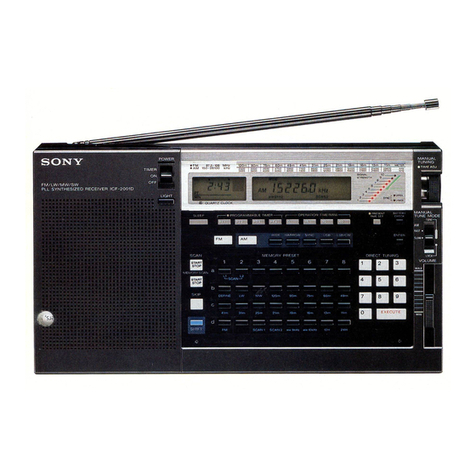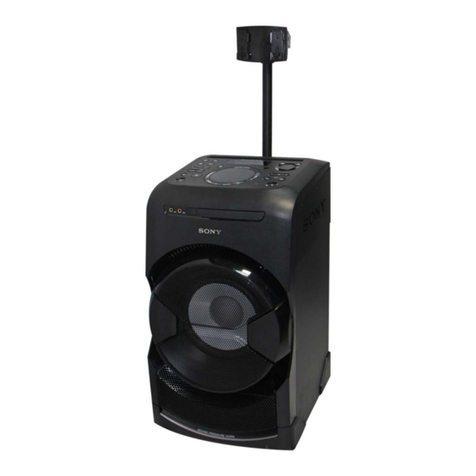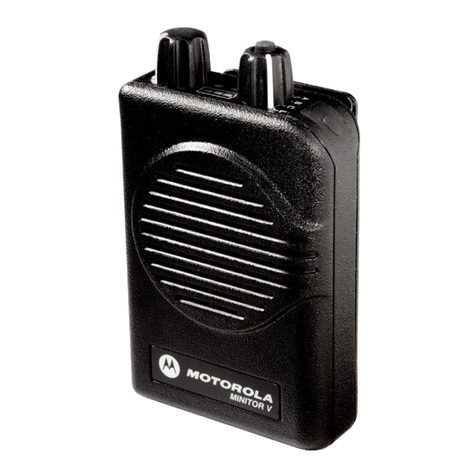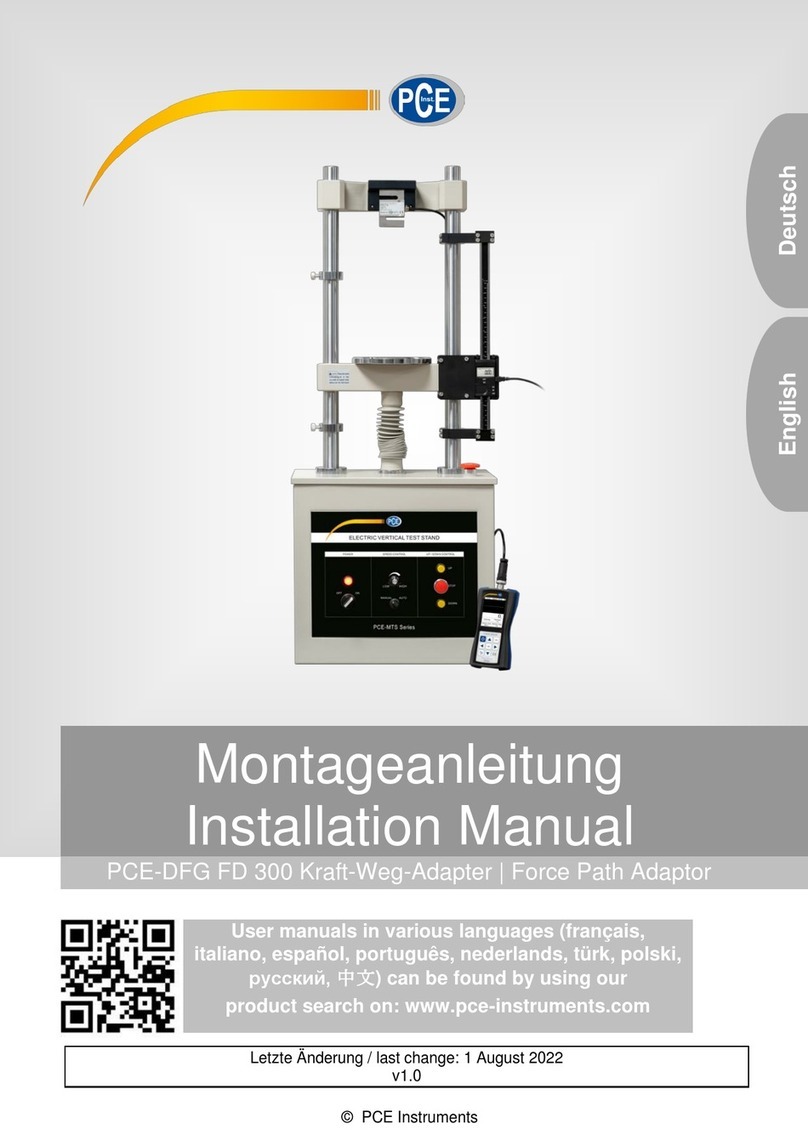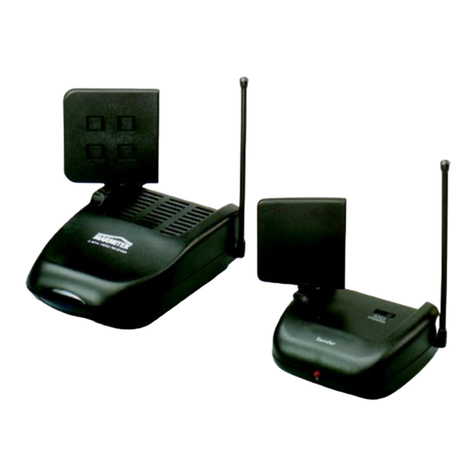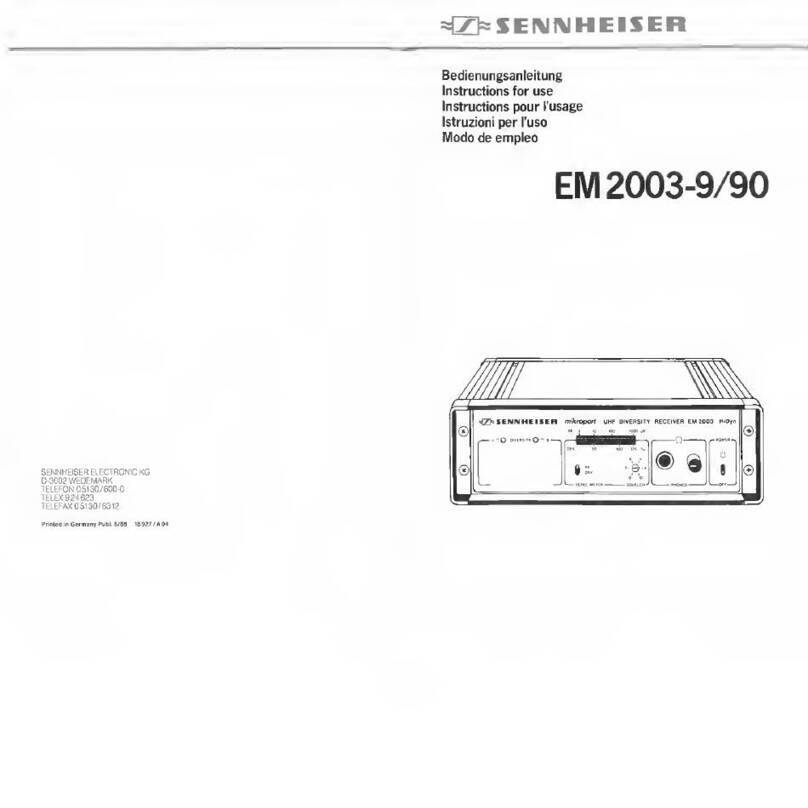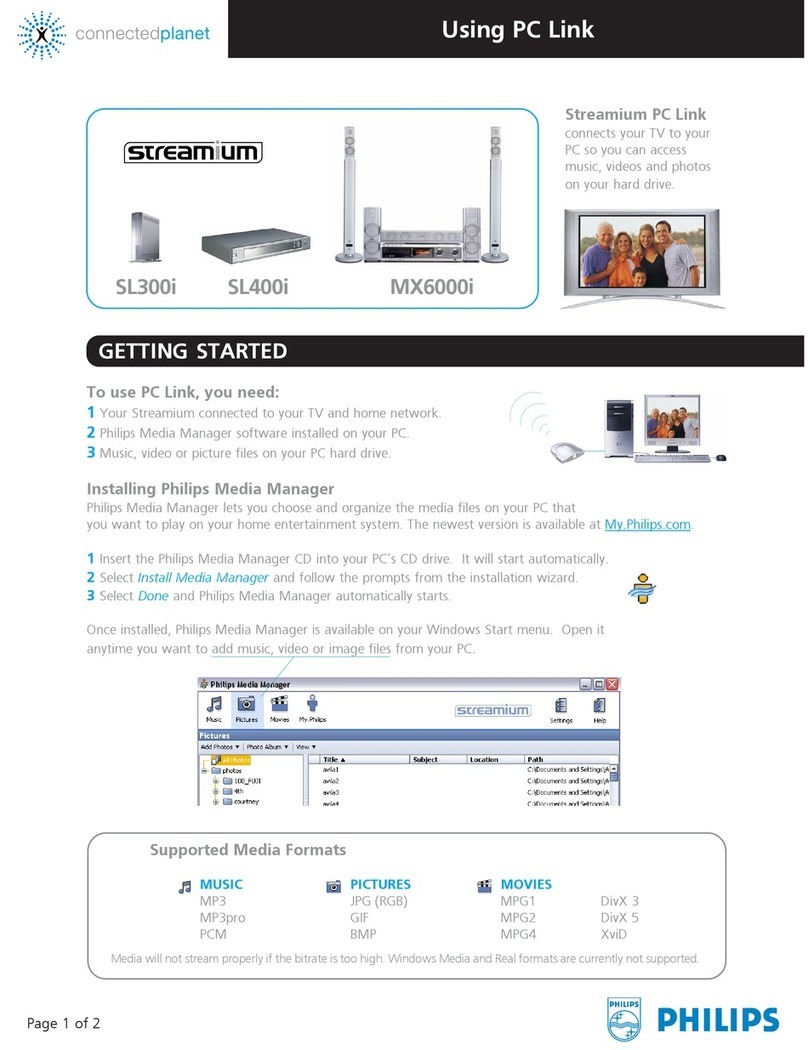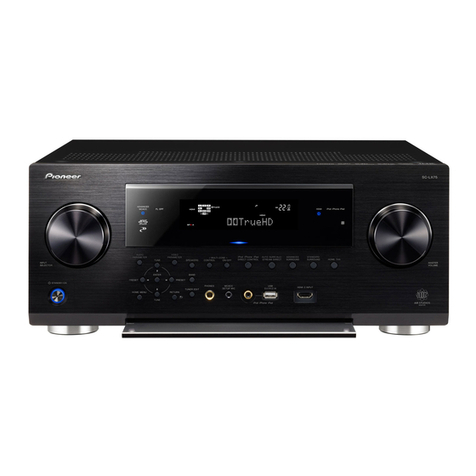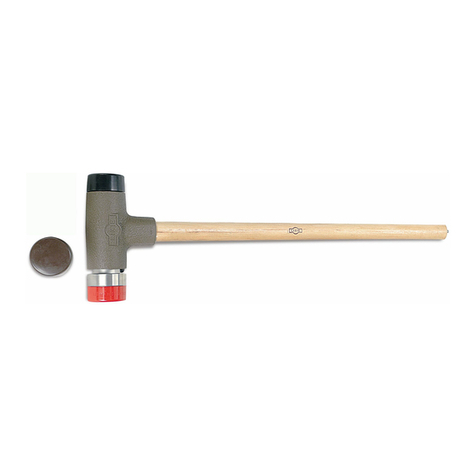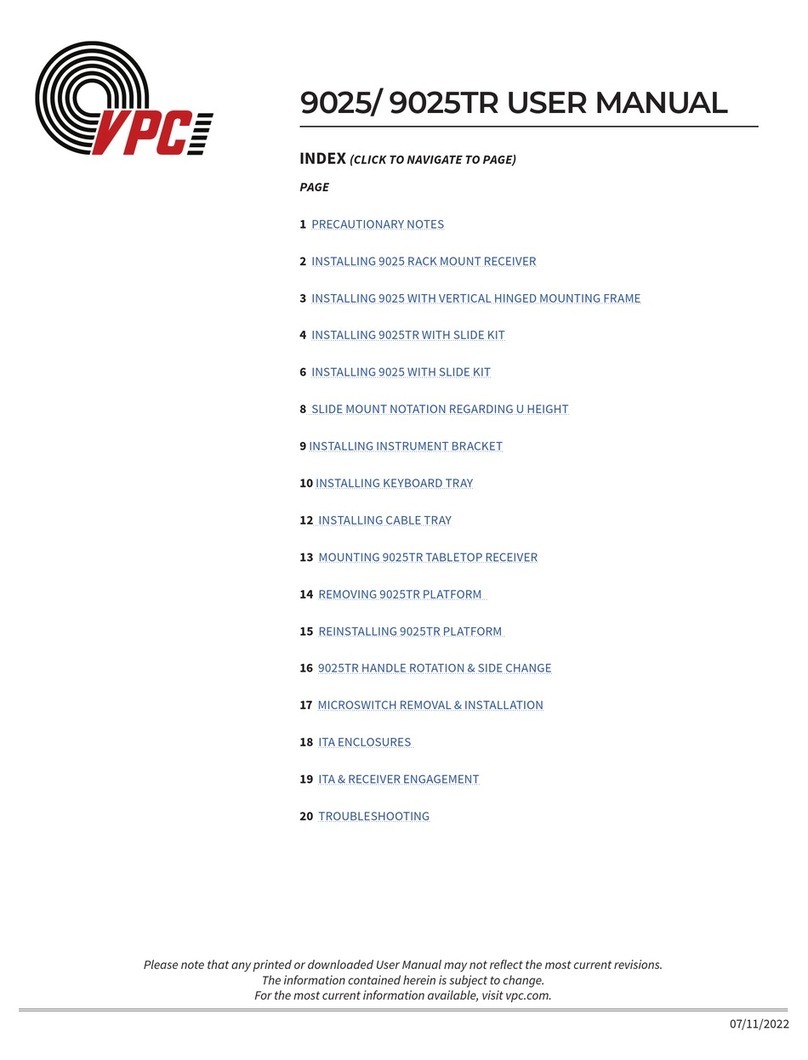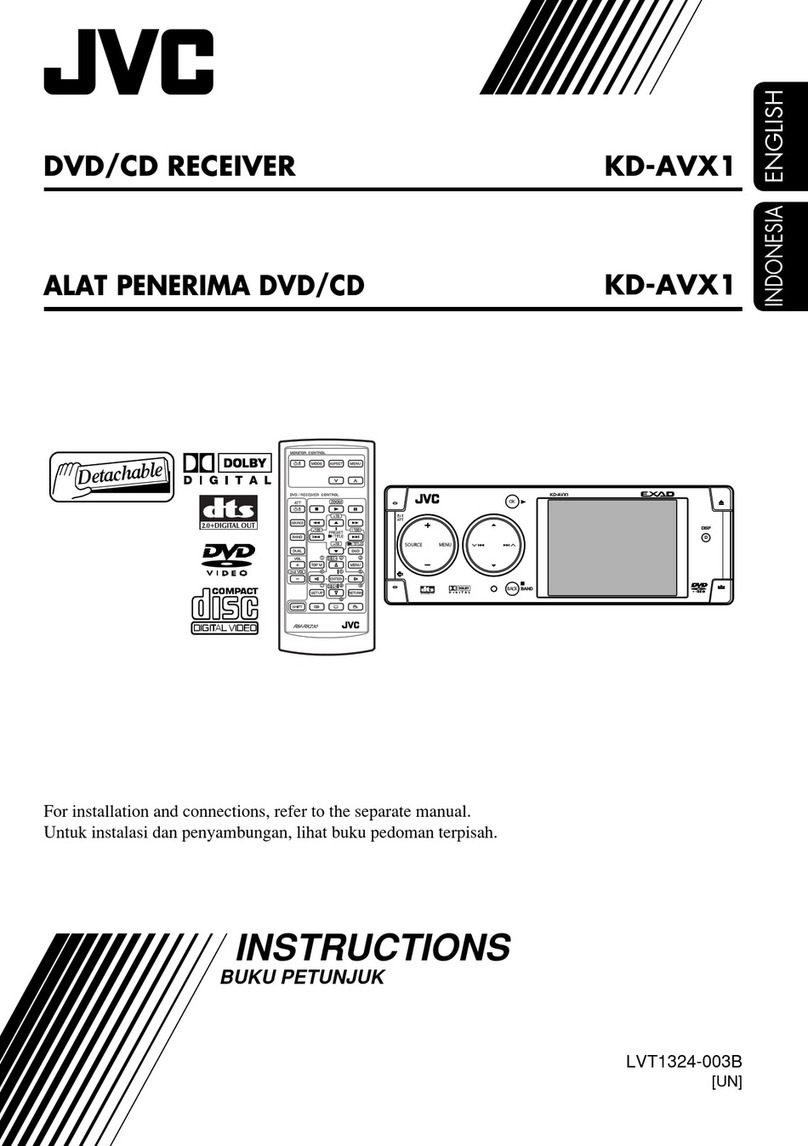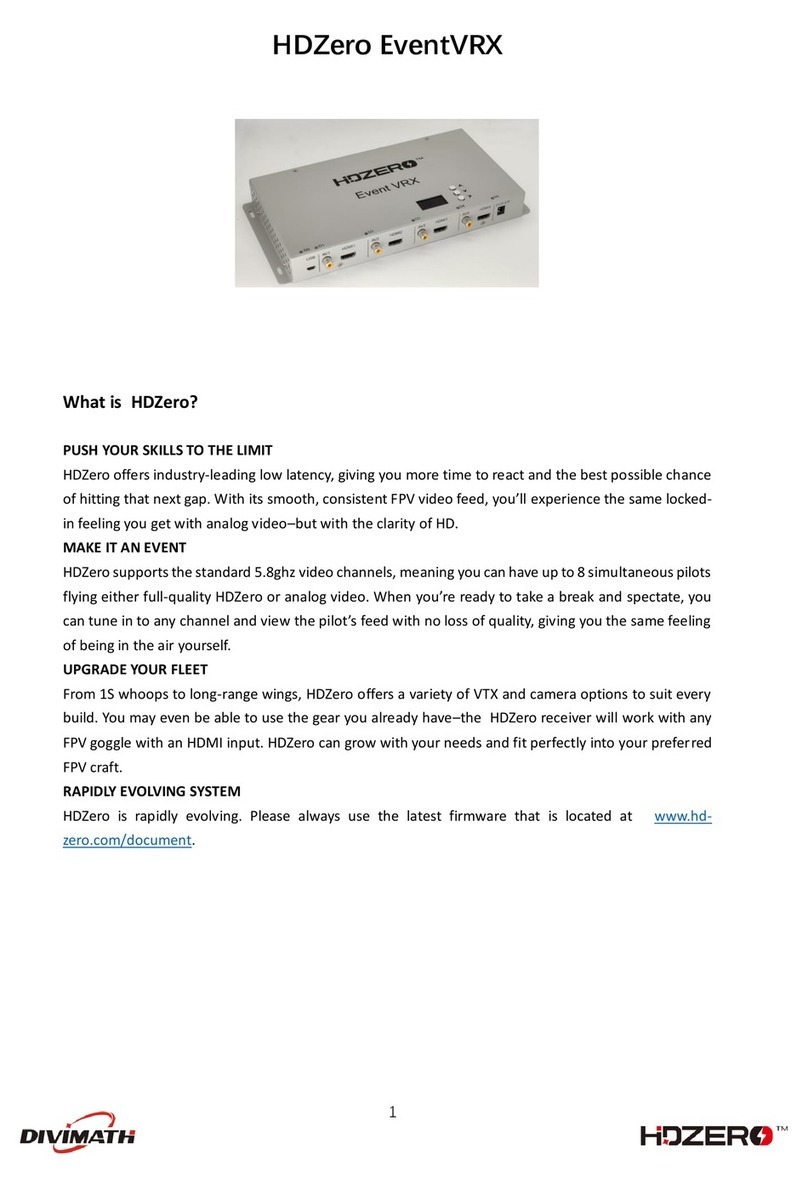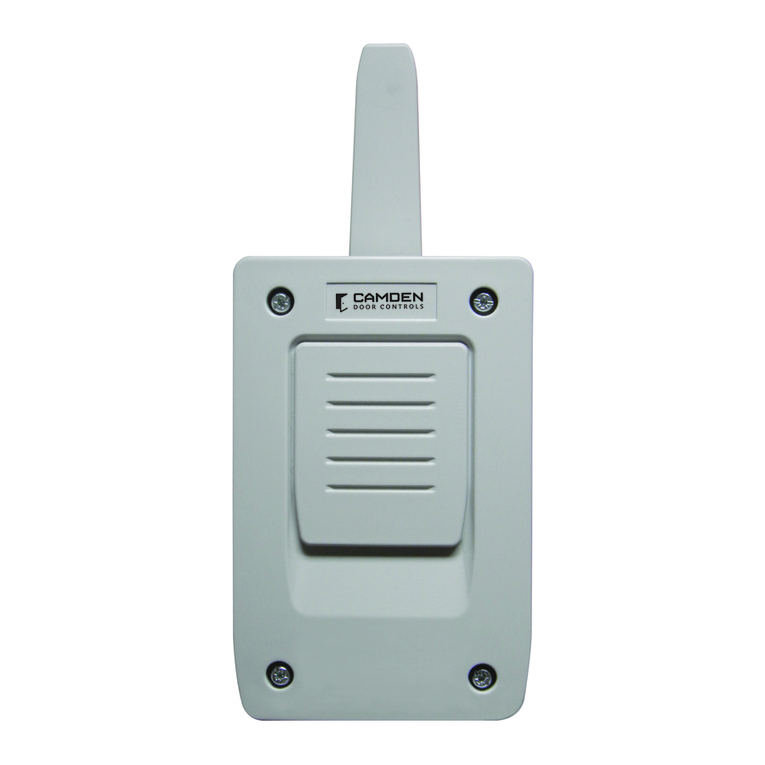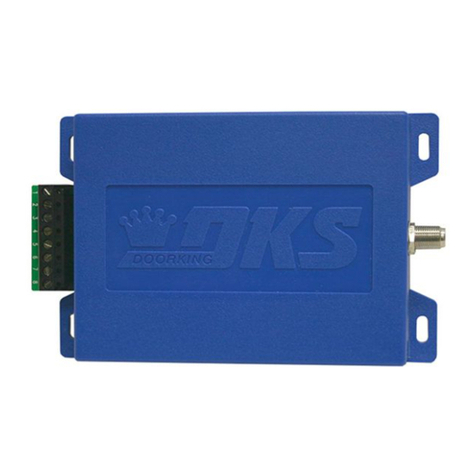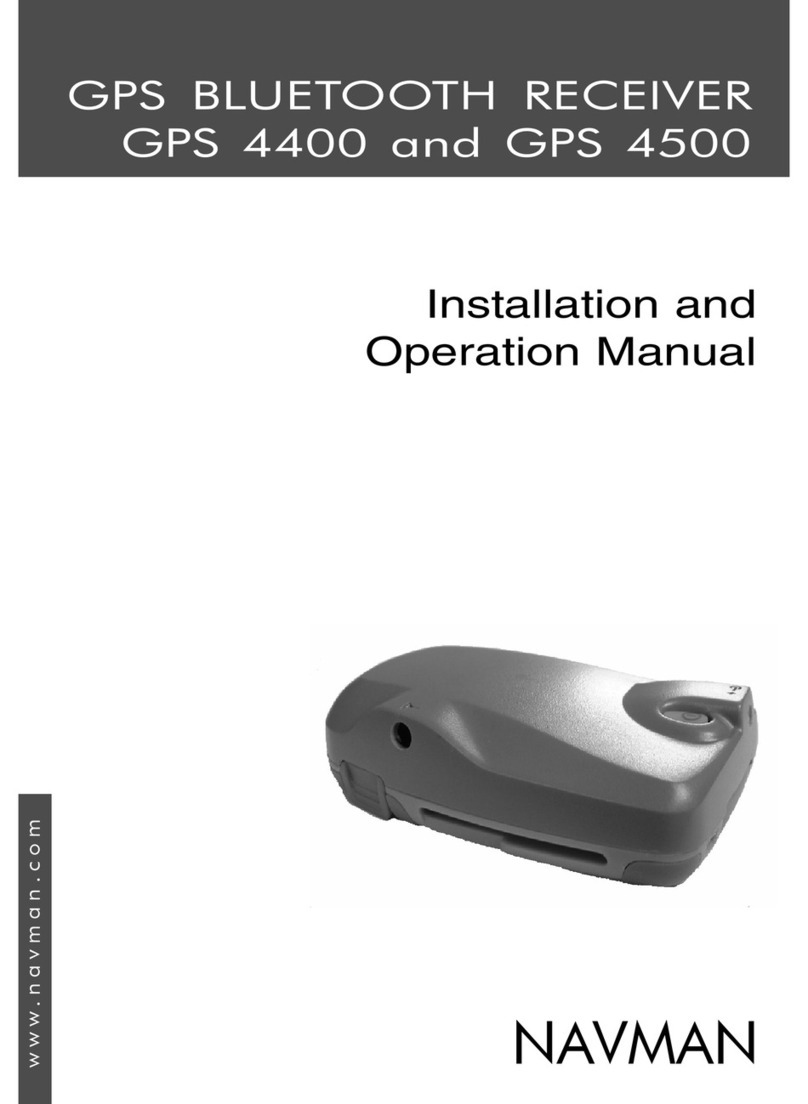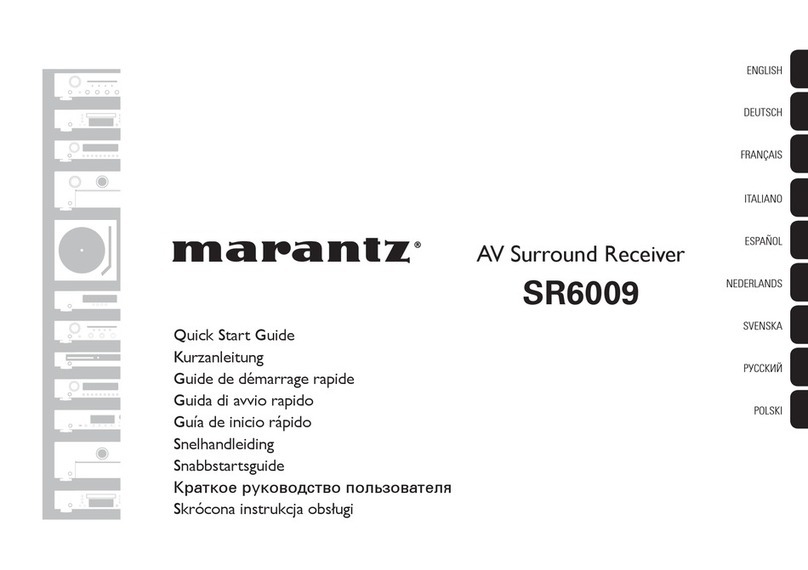Sony STR-W777 User manual

STR-W777
AEP Model
UK Model
E Model
Australian Model
SERVICE MANUAL
FM STEREO/FM-AM RECEIVER
MICROFILM
SPECIFICATIONS
STR-W777 is the tuner and amplifier
section in MHC-W777AV.
Amplifier section
(Saudi Arabia, Singapore, Malaysia,Thai, Australian)
The following measured at AC 230V 50/60 Hz
DIN power output (Rated) (FRONT)
95 + 95W (6 Ωat 1kHz DIN)
Continuous RMS power output (Reference)
FRONT SPEAKER: 110 + 110W
(6 Ωat 1kHz, 10% THD)
CENTER SPEAKER: 55W
(8 Ωat 1kHz, 10% THD)
REAR SPEAKER: 35 + 35W
(8 Ωat 1kHz, 10% THD)
The following measured at AC 120, 220, 240V 50/60Hz
DIN power output (Rated) (FRONT)
100 + 100W (6 Ωat 1kHz DIN)
Continuous RMS power output (Reference)
FRONT SPEAKER: 120 + 120 W
(6 Ωat 1kHz, 10% THD)
CENTER SPEAKER: 60W
(8 Ωat 1kHz, 10% THD)
REAR SPEAKER: 40 + 40W
(8 Ωat 1kHz 10% THD)
Peak music power output 2400W
(AEP, UK, East European, CIS)
DIN power output (Rated) (FRONT)
80 + 80W (6 Ωat 1kHz DIN)
Continuous RMS power output (Reference)
FRONT SPEAKER: 100 + 100W
(6 Ωat 1kHz, 10% THD)
CENTER SPEAKER: 60W
(8 Ωat 1kHz, 10% THD)
REAR SPEAKER: 35 + 35W
(8 Ωat 1kHz, 10% THD)
Music power output (Reference)
FRONT SPEAKER: 190 + 190 W
(6 Ωat 1kHz, 10% THD)
CENTER SPEAKER: 90W
(8 Ωat 1kHz, 10% THD)
REAR SPEAKER: 55 + 55W
(8 Ωat 1kHz, 10% THD)
Inputs MD/VIDEO 1 IN (phone jacks): voltage
450/250mV, impedance 47kΩ
AV INPUTAUDIO (phone jacks): voltage
250mV, impedance 47kΩ
MIX MIC (phone jack): sensitivity 1mV,
impedance 10kΩ
— Continued on next page —

— 2 —
Output MD/VIDEO 1 OUT (phono jacks): voltage
450/250mV, impedance 1kΩ
PHONES (stereo phone jack): accepts
headphones of 8Ωor more.
FRONT SPEAKER:
accepts impedance of 6 to 16Ω
CENTER SPEAKER:
accepts impedance of 8 to 16Ω
REAR SPEAKER:
accepts impedance of 8 to 16Ω
SUPER WOOFER:
Voltage 1V, impedance 1kΩ
Video section
Inputs AV INPUTVIDEO (phone jack): 1Vp-p, 75Ω
Outputs MONITOR OUT (phone jack): 1Vp-p, 75Ω
Tuner section
FM stereo, FM/AM superheterodyne tuner
FM tuner section
Tuning range
3 band type model 87.5 – 108.0MHz (50kHz step)
4 band type model 65.0 – 74.0MHz (10kHz step)
87.5 – 108.0MHz (50kHz step)
Aerial FM lead aerial
Aerial terminals 75Ωunbalanced
Intermediate frequency 10.7MHz
UKV tuner section (4 band type model only)
Tuning range 65.0 – 74.0MHz (10kHz step)
Polar Stereo
AM tuner section
Tuning range
Australian model: 531 – 1,602kHz (with the AM tuning interval
set at 9kHz)
530 – 1,710kHz (with the AM tuning interval
set at 10kHz)
Other models: MW: 531 – 1,602kHz (with the MW tuning
interval set at 9kHz)
530 – 1,710kHz (with the MW tuning interval
set at 10kHz)
SW: 5.95 – 17.90MHz (with the SW tuning
interval set at 5kHz)
LW: 153 – 279kHz (with the interval set at
3kHz)
Intermediate frequency 450kHz
Antenna AM loop antenna External antenna terminal
General
Power requirements
Australian models: 240VAC, 50/60Hz
AEP, UK, East European, CIS models:
230VAC, 50/60Hz
Other models: 120V or 220V or 230 – 240, 50/60Hz
Adjustable with voltage selector
Power consumption 270W (AEP, UK, East European, CIS models)
300W (Other models)
Dimensions (w/h/d) Approx. 288 ×205 ×375mm
Mass Approx. 8.8kg
Supplied accessories: AM loop antenna (1)
Remote RM-SR77 (1)
SizeAA (R6) batteries (2)
FM lead antenna (1)
Speaker cords (5)
Front speaker pads (8)
Design and specifications are subject to change without notice.

— 3 —
TABLE OF CONTENTS
1. GENERAL ........................................................................... 4
2. DISASSEMBLY
• Sliding Panel Assembly ......................................................5
3. SERVICE MODE ..............................................................6
4. ELECTRICAL ADJUSTMENT ................................... 11
5. DIAGRAMS
5-1. Circuit Boards Location ··················································· 12
5-2. Block Diagrams
• Tuner Section (AEP, UK model) ····································13
• Tuner Section (East European, CIS model) ··················· 15
• Main Section ··································································17
• Power Section ································································19
5-3. Schematic Diagram
–Tuner (AEP, UK model) Section – ·································23
5-4. Printed Wiring Board
–Tuner (AEP, UK model) Section – ·································25
5-5. Printed Wiring Board
–Tuner (East European, CIS model) Section – ················26
5-6. Schematic Diagram
–Tuner (East European, CIS model) Section – ················27
5-7. Printed Wiring Board – Main Section – ··························· 29
5-8. Schematic Diagram – Main (1/2) Section – ·····················31
5-9. Schematic Diagram – Main (2/2) Section – ·····················33
5-10. Schematic Diagram –AV/Mic Section – ·························· 35
5-11. Printed Wiring Board –AV/Mic Section – ······················· 36
5-12. Schematic Diagram – PowerAmp Section – ··················· 37
5-13. Printed Wiring Board – Power Amp Section –·················39
5-14. Schematic Diagram – Display Section – ··························41
5-15. Printed Wiring Board – Display Section – ······················· 43
5-16. Schematic Diagram – Sliding Panel Section –················· 45
5-17. Printed Wiring Board – Sliding Panel Section – ·············· 47
5-18. Schematic Diagram – Surround Section – ······················· 49
5-19. Printed Wiring Board – Surround Section –····················· 51
5-20. Printed Wiring Board – Trans Section –··························· 53
5-21. Schematic Diagram – Trans Section – ····························· 55
5-22. IC Block Diagrams··························································· 56
5-23. IC Pin Function ································································ 60
6. EXPLODED VIEWS
6-1. Case and Sliding Panel Section ........................................63
6-2. Front Panel Section .......................................................... 64
6-3. Slide Mechanism Section ................................................. 65
6-4. Circuit Boards and Back Panel Section............................66
7. ELECTRICAL PARTS LIST ........................................67
SAFETY-RELATED COMPONENT WARNING !!
COMPONENTS IDENTIFIED BY MARK !OR DOTTED LINE
WITH MARK !ON THE SCHEMATIC DIAGRAMS AND IN
THE PARTS LIST ARE CRITICAL TO SAFE OPERATION.
REPLACE THESE COMPONENTS WITH SONY PARTS
WHOSE PART NUMBERS APPEAR AS SHOWN IN THIS
MANUAL OR IN SUPPLEMENTS PUBLISHED BY SONY.
LABEL MODEL NUMBER
No.
MODEL IDENTIFICATION
— BACK PANEL —
SaudiArabia, Singapore, Malaysia 4-900-848-2π
Thai, Australian 4-900-848-3π
AEP, UK, East European, CIS 4-900-848-4π
MODEL PART No.

— 4 —
Front Panel
SECTION 1
GENERAL
1 2 3 4 5 6 7
8
9
!º
!¡
!™
!£
!¢
!∞
!¶!§
@∞
@§
@¶
@•
@ª
#£
#¢
#º
!•
!ª
@¡
@£
@¢ @º
#¡
#™
@™
Rear Panel 2
4
53
1
6
7
1MOVIE button
2MUSIC button
3GAME button
4PLACE button
5P FILE button
6EFFECT ON/OFF button
7OPEN/CLOSE button
8TUNER BAND button
9STEREO/MONO button
!º MEMORY button
!¡ KARAOKE PON/MIX button
!™ MIC LEVEL dial
!£ MIX MIC jack
!¢ GROOVE button
!∞ VOLUME dial
!§ )+ button
!¶ ENTER/NEXT button
!• MULTI JOG STATION dial
!ª 0– button
@º NON-STOP button
@¡ EDIT button
@™ FLASH button
@£ PLAY MODE button
@¢ REPEAT button
@∞ PHONES jack
@§ LOOP button
@¶ CLOCK/TIMER SET button
@• TIMER SELECT button
@ª FUNCTION button
#º PROLOGIC button
#¡ DSP button
#™ DBFB button
#£ DISPLAY/DEMO button
#¢ I/u(POWER) button
1SYSTEM CONTROL jack
2ANTENNA terminal
3CENTER SPEAKER terminal
4REAR SPEAKER terminal
5MONITOR OUT jack
6FRONT SPEAKER terminal
7MD/VIDEO 1 jack

— 5 —
SECTION 2
DISASSEMBLY
Note: Follow the disassembly procedure in the numerical order given.
2-1. SLIDING PANEL ASSEMBLY
4
Flat type cable (19 core)
2
Screw (BVTP 3x8)
3
Holder level
5
Sliding panel assembly
Slide mechanism
1
Push the OPEN/CLOSE button to
open the Sliding panel assembly.
1
Screw (BVTP2.6x8)
4
Four screw
(BVTP2.6x8)
5
Holder (L) assembly
a
a
b
b
6
Four screw (BVTP2.6x8)
7
Holder (R) assembly
8
Remove the Level slider direction of arrow.
2
Screw
(BVTP2.6x8)
3
Top bracket
•NOTE FOR INSTALLATION (LEVEL SLIDER)
NOTE :
Attach in the reverse order, but make sure the rollers (
a
,
b
) of the
holder (L) assembly and holder (R) assembly fit into the grooves of
the level slider.

— 6 —
SECTION 3
SERVICE MODE
Connections and Operations When Used Alone
Normally, use the unit connected to the HTC-W555 as follows.
Basically, when servicing the unit, connect the unit as follows.
Even when not connected to the HTC-W555, the unit can operate alone as it mounts a power supply (some functions will however not be
available).
MC Cold Reset
• The cold reset clears all data including preset data stored in the RAM to initial conditions. Execute this mode when returning the set to the
customer.
Procedure:
1. Press three buttons EDIT , ENTER/NEXT , and DISPLAY/DEMO simultaneously.
2. The fluorescent indicator tube becomes blink instantaneously, and the set is reset.
CD Delivery Mode (This mode can be used only when the HTC-W555 is connected.)
• This mode moves the pick-up to the position durable to vibration. Use this mode when returning the set to the customer after repair.
Procedure:
1. Press 1/u button to turn the set ON.
2. Press LOOP button and 1/u button simultaneously.
3. A message “LOCK” is displayed on the fluorescent indicator tube, and the CD delivery mode is set.
MC Hot Reset
• This mode resets the set with the preset data kept stored in the memory. The hot reset mode functions same as if the power cord is plugged
in and out.
Procedure:
1. Press three buttons REPEAT , ENTER/NEXT , and DISPLAY/DEMO simultaneously.
2. The fluorescent indicator tube becomes blink instantaneously, and the set is reset.
Sled Servo Mode (This mode can be used only when the HTC-W555 is connected.)
• This mode can run the CD sled motor freely. Use this mode, for instance, when cleaning the pick-up.
Procedure:
1. Select the function “CD”.
2. Press three buttons FLASH , ENTER/NEXT , and KARAOKE PON/MIX simultaneously.
3. The Sled Servo mode is selected, if “CD” is blinking on the fluorescent indicator tube.
4. With the CD in stop status, press )+ button move the pick-up to outside track, or – 0button to inside track.
5. To exit from this mode, perform as follows:
1) Move the pick-up to the most inside track.
2) Press three buttons in the same manner as step 2.
Note:
• Always move the pick-up to most inside track when exiting from this mode. Otherwise, a disc will not be unloaded.
• Do not run the sled motor excessively, otherwise the gear can be chipped.
Change-over of FUNCTION Name
• The FUNCTION name of external input terminal can be changed over to VIDEO 1 or MD.With the FUNCTION selected to “MD”, about
5dB mute is applied to the input gain.
Procedure:
1. Press 1/u button to turn the set OFF.
2. Press 1/u button together with FUNCTION button, and the power is turned on, the display of fluorescent indicator tube changes to
“MD” or “VIDEO 1” instantaneously, and thus the FUNCTION is changed over.
Change-over of AMTuner Step between 9kHz and 10kHz
• A step of AM channels can be changed over between 9kHz and 10kHz.
Procedure:
1. Press 1/u button to turn the set ON.
2. Select the function “TUNER”, and press TUNER/BAND button to select the BAND “MW”.
3. Press 1/u button to turn the set OFF.
4. Press ENTER/NEXT and 1/u buttons simultaneously, and the display of fluorescent indicator tube changes to “MW step 10” or
“MW step 9”, and thus the channel step is changed over.
AC IN
UNIT HTC-W555
SYSTEM CONTROL 17P

— 7 —
LED and Fluorescent IndicatorTube All Lit,Key Check Mode (Do not connect the HTC-W555.)
Procedure:
1. Press 1/u button to turn the set ON.
2. Press the OPEN/CLOSE button to open the sliding panel.
3. Press three buttons DELAY , ENTER/NEXT , and DISPLAY/DEMO simultaneously.
4. LEDs and fluorescent indicator tube are all turned on. Each time the MOVIE button is pressed, the fluorescent indicator tube lights up
as follows:
lights up completely nlights up partially 1 nlights up partially 2 nlights up completely.
5. Press GAME button, and the key check mode is activated.
6. In the key check mode, the fluorescent indicator tube displays “K @@ V0 J0”. Each time a button is pressed, “K”value decreases.
However, once a button is pressed, it is no longer taken into account. (@@ means the total of buttons)
“J” Value increases like 1, 2, 3 ... if rotating JOG knob in “+” direction, or it decreases like 0, 9, 8 ... if rotating in “-” direction.
“V” Value increases like 1, 2, 3 ... if rotating VOLUME knob in “+” direction, or it decreases like 0, 9, 8 ... if rotating in “-” direction.
7. Pressing all buttons lights up the fluorescent indicator tube completely.
8. To exit from this mode, press three buttons EDIT , ENTER/NEXT and DISPLAY/DEMO simultaneously. (COLD RESET)
9. To exit from this mode, press three buttons in the same manner as step 1, or disconnect the power cord.
CD,TAPE Deck Aging Mode (This mode can be used only when the HTC-W555 is connected.)
This mode can be used for checking the operations of the CD player and tape deck.
• When problems occur;
Aging stops, and the stopped state is displayed on the fluorescent indicator tube.
• When no problems;
Aging continues.
Preparations:
• Set the CD on the DISC1 tray.
• Insert a commercially available tape for recording (tapes which contents can be erased, etc.) in decks Aand B.
Setting the aging mode:
Press the PLAY MODE button, ENTER/NEXT button, and STEREO/MONO button together.
When the aging mode is set, the CD roulette mark blinks. To exit the mode, press the 1/u button and turn OFF the power.
Sequence:
The aging mode is executed in the following sequence.
If the function is set to “CD” when the aging mode is set, aging is performed starting from the CD player. When set to “TAPE A” or “TAPE
B”, aging is started from deck A.
If the function is set to others, aging will not be started until the function is switched to CD or TAPE.
Display of status:
• The aging status is displayed on the fluorescent indicator tube.
• Normally, the CD player displays the remaining aging time. But if operations ended abnormally, it displays the cause.
• During the aging of the tape deck, the operations performed will be displayed. If operations ended abnormally, this will be displayed at the
fluorescent display tube.
CD Player
• During normal operations:
Display of fluorescent indicator tube
**1-@@
**: Displays “CD” and the remaining aging time (minutes) alternately. The remaining aging time is counted down from 12.
@@: Track number being accessed.
Aging of CD player (12 minutes)
Aging of deck A
Aging of deck B 12 minutes

— 8 —
• When operations end abnormally:
Display of fluorescent display tube
Display of Operations Operation
TAPE AAG-1
TAPE AAG-2
TAPE AAG-3
TAPE AAG-4
TAPE AAG-5
TAPE B AG-1
TAPE B AG-2
TAPE B AG-3
TAPE B AG-4
TAPE B AG-5
TAPEA REW
TAPEA FWD
TAPEA FF
TAPEA REV
TAPEA REW
TAPE B REW
TAPE B FWD
TAPE B FF
TAPE B REV
TAPE B REW
Timing of Ending
Shutoff
2 minute playback
20 seconds or shutoff
2 minutes playback
Shutoff
Shutoff
2 minute playback
20 seconds or shutoff
2 minute playback
Shutoff
Operations during aging
• Operations are performed in the following sequence during aging.
<CD player>
1. The CD tray rotates and disc 1 is selected.
2. Chucking is performed.
3. TOC is read.
4. Track 1 played back for 2 seconds.
5. The last track is played back for 2 seconds.
6. 1 to 5 is repeated.
7. After 12 minutes of aging, aging is switched to the tape deck.
<Tape Deck>
1. The tape in deck A is rewound to the head.
2. The FWD side is played back for 2 minutes.
3. The tape is fast forwarded (FF) for 20 seconds. The following procedure is performed when the tape end is reached before the 20
seconds.
4. The REV side is played back for 2 minutes.
5. The tape is rewound to the head (REW).
6. The tape in deck B is rewound to the head.
7. The FWD side is played back for 2 minutes.
8. The tape is fast forwarded (FF) for 20 seconds. The following procedure is performed when the tape end is reached before the 20
seconds.
9. The REV side is played back for 2 minutes.
10. The tape is rewound to the head (REW).
11.Aging is switched to the CD player.
Display Main Cause
NO DISC ERR
FOCUS1 ERR
FOCUS2 ERR
GFS ERR
FBIAS ERR
SENSOR ERR
TABLE ERR
TRAY ERR
DISC 1 is NO DISC from the beginning
Focus is not imposed properly
The focus deviated several times after the disc rotated normally
GFS ERROR
Error during focus bias adjustment
DISC 1 was found to be NO DISC by the disc sensor
The table did not rotate normally
The tray containing the BD did not operate normally
Tape Deck

— 9 —
PANEL Aging Mode
This mode is used for opening and closing the sliding panel continuously.
Setting the aging mode :
With the set at standby condition, press FLASH button, ENTER/NEXT button and STEREO/MONO button together.
The aging will start and sliding panel will follow aging sequence as described below.
• When problems occur ;
Aging stops and “AGING ERROR” is displayed on the fluorescent indicator tube.
• When no problems;
Aging is carried out repeatedly.After 65000 times, “AGING STOP” is displayed and aging stops.
Aging Sequence
Counts up
n n
Panel open Panel close
n
Stops for one second in the opened state
Stops for one second in the closed state
Each time the DISPLAY/DEMO button is pressed, the display switches as follows.
Aging @@@@@ (No. of agings carried out)
OP Max @.@@ (Maximum time taken for OPEN:In seconds)
OP Min @.@@ (Minimum time taken for OPEN:In seconds)
CL Max @.@@ (Maximum time taken for CLOSE:In seconds)
CL Min @.@@ (Minimum time taken for CLOSE:In seconds)

— 10 —
Procedure:
1. Supply a 25 dB 98 MHz signal from theANTENNAterminal.
2. Tune the set to 98 MHz.
3. Adjust RV42to the point(moment)when the TUNEDindicator
will change from going off to going on.
Adjustment Location: TCB board
TUNER SECTION 0dB=1µV
Note 1: As a front-end (FE1) is difficult to repair if faulty, replace
it with new one.
Note 2: No adjustment is needed for a tuner pack except for AEP,
UK, East European, CIS models.
AMTuned Level Adjustment
(AEP, UK, East European, CIS model)
Note: FM Tuned LevelAdjustment should be performed after this
AM Tuned Level Adjustment.
Setting:
Band: MW
Procedure:
1. Set the output of SSG so that the input level of the set becomes
55 dB.
2. Tune the set to 999 kHz or 1,050 kHz.
3. Adjust RV41 to thepoint (moment) when theTUNED indicator
will change from going off to going on.
Adjustment Location: TCB board
FMTuned Level Adjustment
(AEP, UK, East European,CIS model)
Note: This adjustment should be performed after the AM Tuned
LevelAdjustment.
Setting:
Band: FM
FM ANTENNA terminal (TM1)
FM RF SSG
75
Ω
coaxial
Carrier frequency: 98MHz
Modulation: AUDIO 1kHz, 75kHz
deviation (100%)
Output level: 25dB (at 75
Ω
open)
set
loop antenna
AM RF SSG
loop antenna
(Supplied accessories)
30% amplitude
modulation by
400Hz signal
Modulation: 999 kHz (at 9 kHz step)
1,050 kHz (at 10 kHz step)
60cm AM antenna
terminal (TM1)
set
Field strength dB (
µ
V/m) = SSG output level dB (
µ
V/m) –26dB.
RV41
AM Tuned Level
TM1
RV42
FM Tuned
Level
IC21
Adjustment Location
[TCB BOARD] (Component Side)
SECTION 4
ELECTRICAL ADJUSTMENT

— 11 —
FM Polar Adjustment (East European, CIS model)
Connection 1 :
Connection 2 :
Procedure :
1. Set the modulation of FM RF SSG to AUDIO 1 kHz, 10 kHz
deviation according to “Connection 1”.
2. Tune the set to 69 MHz.
3. Adjust the RV1702 so that the reading of frequency counter
connected to TP1702 (VCO) becomes within 31.25 kHz ± 0.05
kHz. (VCO adjustment)
4. Then record the readingof the level meterconnected toTP1701.
5. Set the modulation of FM RF SSG to AUDIO 31.25 kHz, 10
kHz deviation according to “Connection 2”.
6. Tune the set to 69 MHz.
7. Set the CT1701 to be mechanical center.
8. Adjust the L1701 so that the reading of the level meter
connected to TP1701 (FILTER) becomes maximum.
Then adjust the CT1701 so that the reading of the level meter
connected to TP1701 (FILTER) becomes maximum. (SUB
CARRIER PEAK Adjustment)
9. Adjust the RV1701 so that the level at the moment becomes 14
dB higher value than the level recorded in step 4. (SUB
CARRIER LEVELAdjustment)
Adjustment Location: TCB board
Adjustment Location:
[TCB BOARD] (Conductor Side)
FM antenna
terminal (75
Ω
)
FM RF SSG 75
Ω
coaxial
Carrier frequency: 69 MHz
Output level: 1 mV (60 dB
µ
) (at 75
Ω
open)
Modulation: AUDIO 1 kHz, 10 kHz deviation
set
FM antenna
terminal (75
Ω
)
Audio 31.25 kHz external
modulation
terminal
FM RF SSG
AF OSC 75
Ω
coaxial
Carrier frequency: 69 MHz
Output level: 1 mV (60 dB
µ
) (at 75
Ω
open)
Modulation: AUDIO 31.25 kHz, 10 kHz deviation
(EXTERNAL MODULATION)
set
frequency counter
level meter
TP1701
(FILTER)
TP1702
(VCO)
IC1701
L1701
CT1701 Sub Carrier Peak
RV1701
Sub Carrier
Level
IC1701
RV1702
VCO
[TCB BOARD] (Component Side)

— 12 —
SECTION 5
DIAGRAMS
5-1. CIRCUIT BOARDS LOCATION
FRONT AV board
PANEL board MAIN board
MOTOR board
DETECTOR board
MIC / ECHO board
POWER AMP board
SURR AMP board
SURR SPK boar
d
PRIMARY board ENCAPSULATED COMPONENT
(EA, SP, MY, TH, AUS)
TCB board (AEP, UK, EE, CIS)
SECONDARY board
HEADPHONE board
CONNECTOR board
LOADING PANEL board
• Abbreviation
EE : East European
EA : Saudi Arabia
SP : Singapore
MY : Malaysia
AUS : Australian
TH : Thai

STR-W777
5-2. BLOCK DIAGRAM –TUNER SECTION – (AEP, UK model)
— 13 — — 14 —
TM1
AM
ANTENNA
FM 75Ω
COAXIAL ANT IN
ST +10V
Q5
VT
FE1
FM FRONT END
IF OUT
CF1
10.7MHz IF AMP
Q1, 2
CF2
10.7MHz IF AMP
Q3, 4
CF3
10.7MHz 1 FM IN
REG
FM/AM MPX
IC41
1710
16
PLL
IC21
11
FM
TUNED
LEVEL
15 13
30 14
RV42
21214 7
10
X42
450kHz
D41
FM SD
ADJ
OSC.BUFF
AM/FM
VCO STOP
IF BUFF
MUTE
AM
SD
AM
TUNED
LEVEL
12 RV41
2AM IF
IFT41 4
9
AM IF
DET STEREO
TUNED 7
6
X41
10.7MHz
MUTE
STEREO
TUNED
23 22
FM DET OUT MPX IN 21
20
OUT L
OUT R
LPF
RCH
19 AMP IN L AMP
OUT
L17
ST L
4
5
3 ST-CE
COM-DIN
COM-CLK
COM-DATA
A
MAIN
SECTION
CE
DI
CL
DO
1 24
X21
4.5MHz
AM MIX
AM
SD
628
5
2
15
17
16
14
12
13
29
26 25 24 23 22 21 20
9
LW SW
Q9
27
FE2
MW/LW FRONTEND
Q11
MW
SW
Q12
MW
SW
Q14
LW SW
Q13
MW
SW
AM OSC
AM RF IN
FM AFC
• R CH: Same as L ch
• SIGNAL PATH
: FM
: MW
RDS DATA
RDS INT
(Page 17)
6
FM
VT1
MW
MW
AM OSC
FM
VCO STOP
FM/AM IF
XIN
XOUT
3
4
13 14
2
16
IC1751 RDS DECODER
IC1752
X1751
4.332MHz
57
FM
ADJ
26
24
AM
DET
OUT

STR-W777
–TUNER SECTION – (East European, CIS model)
— 15 — — 16 —
22 MPX IN 21
OUT L LPF 19 AMP
IN
L AMP
OUT
L17
4
5
3
6
ST-CE
COM-DIN
COM-CLK
COM-DATA
A
MAIN
SECTION
CE
DI
CL
DO
• R CH: Same as L ch
• SIGNAL PATH
: FM
: MW
D42 D43
13
FM LOW
SUB CARRIER
PEAK
L1701CT1701 TP1701 2
3
20
RV1701
SUB CARRIER
LEVEL
7
6
910
POLAR
DECODER
IC1701
IN
POUT
L OUT
R OUT
SUB IN
MON
VCO
ST IND
VCO
STOP
18 17
R CH
13
12
POLAR/PILOT
SWITCH
IC1702
14
9 11
L IN
L OUT
CA
R OUT 4R CH
SWITCH
Q1701
SWITCH
Q1702 SWITCH
Q1703
D1704
D1703
D1701
D1702
ST-L
STEREO
TUNED
MUTE
TP1702 RV1702
VCO
(Page 17)
TM1
AM
ANTENNA
FM 75Ω
COAXIAL ANT IN
ST +10V
Q5
VT
FE1
FM FRONT END
IF OUT
CF1
10.7MHz IF AMP
Q1-4
CF3
10.7MHz 1 FM IN
REG
FM/AM MPX
IC41
1710
16
PLL
IC21
11
FM
TUNED
LEVEL
15 13
30 14
RV42
21214 78
10
X42
450kHz
D41
AM/FM
VCO STOP
IF BUFF
MUTE
AM
SD
AM
TUNED
LEVEL
12 RV41
2AM IF
IFT41 4
9
AM IF
FM
DET STEREO
TUNED 7
6
X41
10.7MHz
1 24
X21
4.5MHz
AM MIX
AM
SD
628
5
2
15
17
16
14
12
13
29
26 25 24 23 22 21 20
9
LW SW
Q9
27
FE2
MW/LW FRONTEND
Q11
MW
SW
Q12
MW
SW
Q14
LW SW
Q13
MW
SW
AM OSC
AM RF IN
FM
VT1
MW
MW
AM OSC
FM
VCO STOP
FM/AM IF
IF REQ
XIN
XOUT
3
OUT R RCH
20
ADJ
FM SD
ADJ
OSC.BUFF
FM AFC
26
23
FM DET OUT
24
AM
DET
OUT
POLA
L IN

STR-W777
– MAIN SECTION –
— 17 — — 18 —
5
3
2
1
SPEANA
SELECTOR
IC505
SPEANA
BPF FILTER
IC506
4
15
22
25
910
26
27
55
56
RESET
LED
ON/OFF
SWITCH
Q531-535,
Q538-540
LED
ON/OFF
SWITCH
Q502-512
SWITCH
Q501
IC891
D504
DATA
CLK
LAT
RST D507
PANEL
LED
+5.6V
RESET
IC502
MIX
MIC
J6001
MIC LEVEL
MUTE
Q183
SW
Q132
DBFB
SELECTOR
IC112
KEY
MATRIX
MULTI JOG
STATION
S653
VOLUME
S652
SLIDING
SENSOR
IC504,Q513
REMOTE
SENSOR
IC503
MUTE
SWITCH
Q121
35
36
16
41
94
SPEANA CONT
Y
Z
SPEANA0
SPEANA1
I2C DATA
I2C CLK
DATA OUT
DATA IN
LAT
CLK
ST MUTE
STREO
TUNED
RDS DATA
RDS CLK
AV IN
POWER ON/OFF
KEY0
I
KEY3
JOG A
JOG B
VOL A
VOL B
SENSOR IN
SIRCSN
GEQ DATA
VA CS
Y1
Y2
Z1
Z2 4
16
17 f1
f2
15 f3
14 f4
13 f
LINE
IN
GEQ CLK
37
38
32
5
6
16
G0
G15
DATA
CLK
CS
RESET
DATA
CLK
LAT
RST
MIC AMP
IC6001(2/2)
FL601
DISPLAY CONTROL
IC601
FLUORESCENT
INDICATOR
TUBE
15
14
13
76 1
RV6001(1/2)
MIC AMP
IC6001(1/2)
3
2
10
MASTER CONTROL
IC501
92
90
89
93
B
POWER
SECTION
COM DIN
ST L
COM DATA
ST CE
COM CLK
MUTE
STEREO
TUNED
AEP,UK
RDS DATA
RDS INT
POWER ON/OFF
A
TUNER
AEP, UK, EE, CIS
EXCEPT AEP, UK,
EE, CIS
AEP, UK, EE, CIS
FM/AM TUNER
TUNER UNIT IS
SUPPLIED AS
THE ASSEMBLED
BLOCK
SECTION
(Page 14, 16)
(Page 19)
(Page 19)
• R CH: Same as L ch
• SIGNAL PATH
: FM
: AUDIO(AV INPUT)
: MD/VIDEO
: VIDEO
: PB
: VIDEO(AV INPUT)
: REC
: CD
20
C
POWER
SECTION
16
43
10 11
21
18
19
42
17
86
87
88
R-CH
R-CH
R-CH
AV SWITCH
Q6301
96
97
GEQ LAT 95
LAT2
3
LEVEL A 2
2
1
3
DBFB B2 5
DBFB B1 6
42 41
33
123
24
OSC1
CLK DATA
OSC2
DOLBY PRO-LOGIC
IC300 AMP
IC361
MUTE
Q361,371
32 34
VIDEO
L-CH
S/W
MUTE
L+R
S OUT
C OUT
TA MUTE
38
36
VOLUME
IC111(2/2)
40
AMP
IC113(2/2)
39
59
60
57
58
TA MUTE
LED
LED
FL DATA
FL CLK
FL LAT
RESET
FL RESET
ACCUT
MOTOR 1
MOTOR 2
X2 X1
X501
5MHz
46
49 50 54 51 5352
47 X301
8MHz
X502
32kHz
XT2 XT1
7
63
I
67
70
72
73
50
I
54
57
I
62
.
.
.
.
82
83
84
85
13 14
MM891
PANEL
MOTOR
PANEL
OPEN/CLOSE
S892
MOTOR
DRIVER
LEVEL B
99
LAT1 98
VF1
VF2
AC1
AC2
28
I
31
2
1
CN101
J6301
J101
J101
TO
HTC-W777
VIDEO
AUDIO L
AV INPUT
(VIDEO 2)
7
9
5R-CH(REC R)
R-CH(CD R)
R-CH(PB R)
IIC DATA
IIC CLK
AC1
AC2
6
17
13
14
16
69
65
DET
D131
68
SELECT
SWITCH EQ
AMP
CD
VIDEO1
V2
MD/V1
TC
TU
2
66
67 4MICON
INTERFACE
61
57
L IN L OUT
31
C OP OUT 33 5
37
1
S OP OUT
12
I
1
64
I
61
59
I
33
31
I
23
S0
S35
SYSTEM
CONTROL
MD/
VIDEO 1
MD
VIDEO 1
IN L
IN L
OUT LREC
AEP,UK
AEP, UK, EE, CIS
15
EQ
IC111(1/2)
64
ENABLE
ENABLE2
R-CH

STR-W777
– POWER SECTION –
— 19 — — 20 —
• R CH : Same as L ch
• SIGNAL PATH
: FM
:VIDEO (AV INPUT)
• Abbreviation
EA
SP
MY
: Saudi Arabia model.
: Singapore model.
: Malaysia model.
R-CH
R-CH
R-CH
D751
D761
RY751
RY781
OVER LOAD
DET
Q952
OVER LOAD
SWITCH
Q851
POWER AMP
IC901
PROTECTOR
IC851
L-CH
L+R
S/W
VIDEO
TA MUTE
MUTE
POWER ON/OFF
EA,SP,MY
AC
IN
PHONES
J755
MONITOR
OUT
J781
FRONT
SPEAKER
TB751
M
M901
FAN
ST+10V
UNREG
+12V
+7V
+5.6V
+5V D813
-7V
+B
-B
VG
R-CH
MOTOR
MUTE
SWITCH
Q901
MUTE
Q181
SWITCH
Q853
D852,853
PROTECTOR VCC ON
MUTE
ST+10V
REG
IC804
VOLTAGE
SELECTOR
S871
VF1
VF2
AC1
AC2
T901
POWER
TRANSFORMER
MAIN
SECTION
B
16
(Page 17)
8
1
4
3 1
6
7
2
20 15
SURR +B
SURR -B
RECT
D810,811
+7V REG
IC801
+5.6V REG
IC803
FAN MOTOR
REG
Q731,732
POWER ON
MUTE
Q852
RECT
D805-808
RECT
D801
RECT
D802, 803
VG REG
Q801
31
31
32
-7V REG
IC802
VF1
VF2
AC1
AC2
L
D746
RY741
OVER LOAD
DET
Q4052
POWER AMP
IC4001(1/2)
REAR
SPEAKER
CENTER
SPEAKER
TB201
L
18 13
OVER LOAD
DET
Q4002
POWER AMP
IC4001(2/2)
110
R
+
–
+
–
RECT
D809
+
–
MAIN
SECTION
C
(Page 17)
S OUT
C OUT

THIS NOTE IS COMMON FOR PRINTED WIR-
ING BOARDS AND SCHEMATIC DIAGRAMS.
(In addition to this, the necessary note is printed
in each block.)
For schematic diagrams.
Note:
• All capacitors are in µF unless otherwise noted. pF: µµF
50 WV or less are not indicated except for electrolytics
and tantalums.
• All resistors are in Ωand 1/4W or less unless otherwise
specified.
•¢: internal component.
•2: nonflammable resistor.
•1: fusible resistor.
•C: panel designation.
For printed wiring boards.
Note:
•X: parts extracted from the component side.
•Y: parts extracted from the conductor side.
•p: parts mounted on the conductor side.
•®: Through hole.
•¢: internal component.
•b: Pattern from the side which enables seeing.
•U: B+ Line.
•V: B– Line.
•H: adjustment for repair.
• Voltages and waveforms are dc with respect to ground
under no-signal (detuned) conditions.
• Voltagesare taken withaVOM (Inputimpedance10 MΩ).
Voltage variations may be noted due to normal produc-
tion tolerances.
• Waveforms are taken with a oscilloscope.
Voltage variations may be noted due to normal produc-
tion tolerances.
• Circled numbers refer to waveforms.
• Signal path.
F: FM
f: AM
L: AUDIO (AV INPUT)
g: MD/VIDEO
i: VIDEO (AV INPUT)
E: PB (DECK A)
G: REC (DECK B)
J: CD
• Abbreviation
EE : East European model.
EA : Saudi Arabia model.
SP : Singapore model.
MY : Malaysia model.
AUS : Australian model.
TH : Thai model.
Note:The components identified by mark !or dotted line
with mark !are critical for safety.
Replace only with part number specified.
• Indication of transistor
CThese are omitted
EB
Q
C
These are omitted
EB
— 21 —

– 22 –
Waveforms
1
2
IC1752 !¢ OEC O
IC21 @¢ XOUT
– TUNER SECTION –
(AEP, UK model)
4.332MHz
2Vp-p
1
IC21 @¢ XOUT
– Tuner Section –
(East European, CIS model)
1
2
IC501 !£ XT2
IC501 0X2
– DISPLAY Section –
5MHz
5.5Vp-p
4.5MHz
4.2Vp-p
32.768kHz
5Vp-p
4.5MHz
4.2Vp-p

STR-W777
5-3. SCHEMATIC DIAGRAM –TUNER SECTION – (AEP, UK model) • Refer to page 22 for Waveforms.
• Refer to page 56 for IC Block Diagrams.
— 23 — — 24 —
(Page 32)
16

— 25 —
STR-W777
5-4. Printed Wiring Board –Tuner Section – (AEP, UK model)
• Refer to page 12 for Circuit Boards Location.
(Page 30)
16
Ref. No. Location
D21 D-1
D41 D-2
D42 E-3
D1751 F-2
IC21 D-1
IC41 C-3
IC1751 E-1
IC1752 F-3
Q1 D-1
Q2 D-1
Q3 C-2
Q4 C-2
Q5 C-2
Q9 B-1
Q11 B-3
Q12 A-3
Q13 A-2
Q14 A-2
• Semiconductor
Location
Other manuals for STR-W777
1
Table of contents
Other Sony Receiver manuals
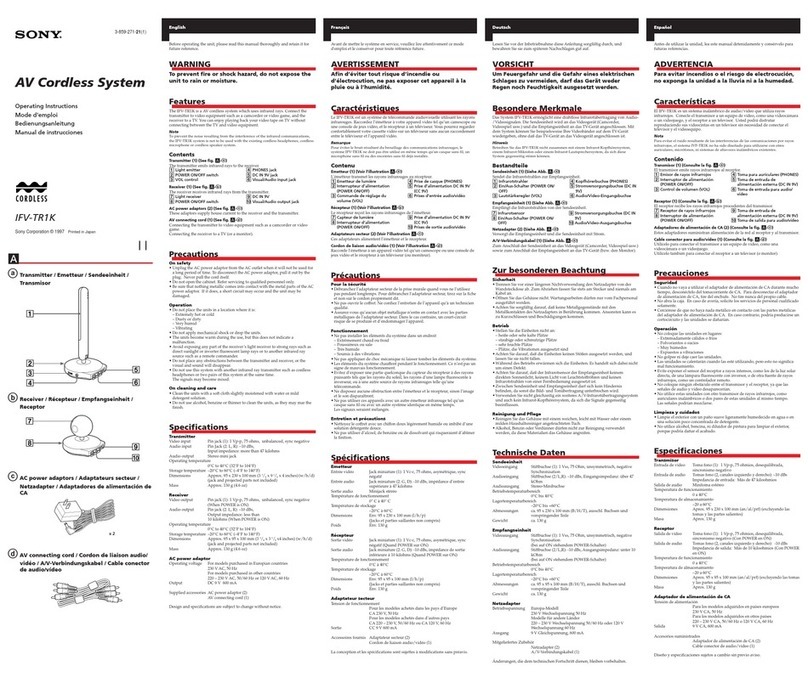
Sony
Sony SB-V40 - AV Selector - Dark User manual
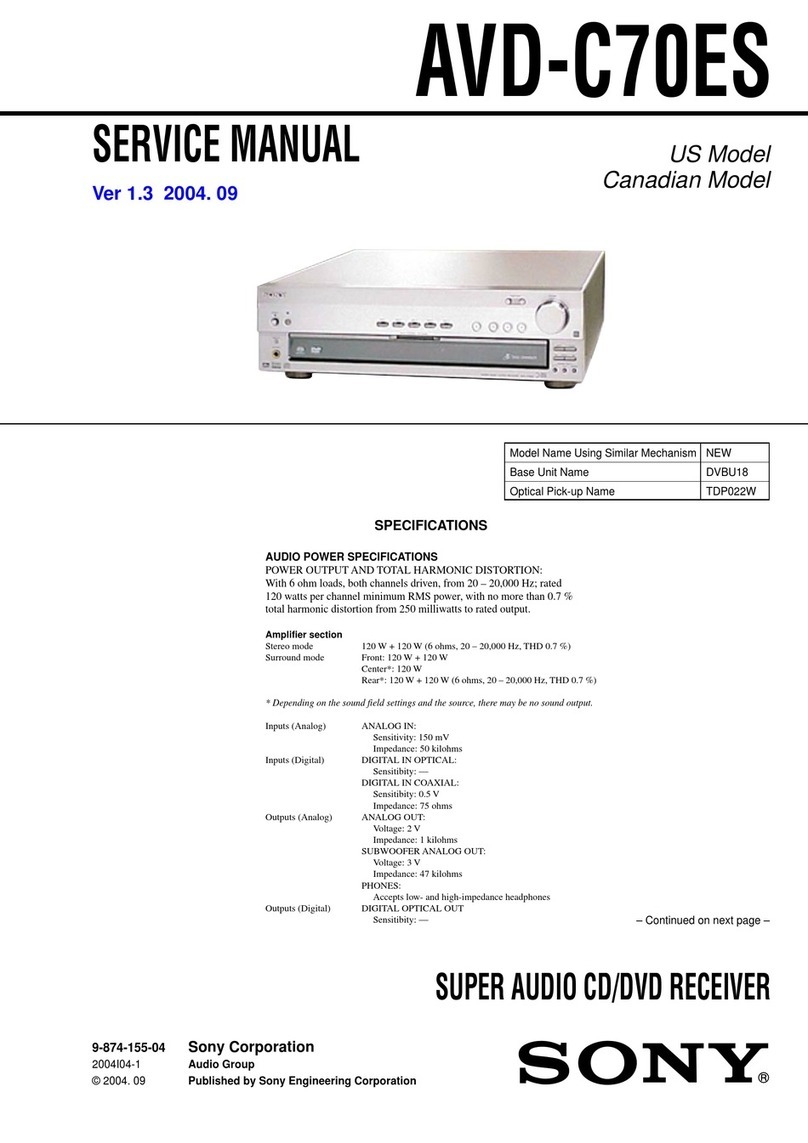
Sony
Sony AVD-C70ES User manual
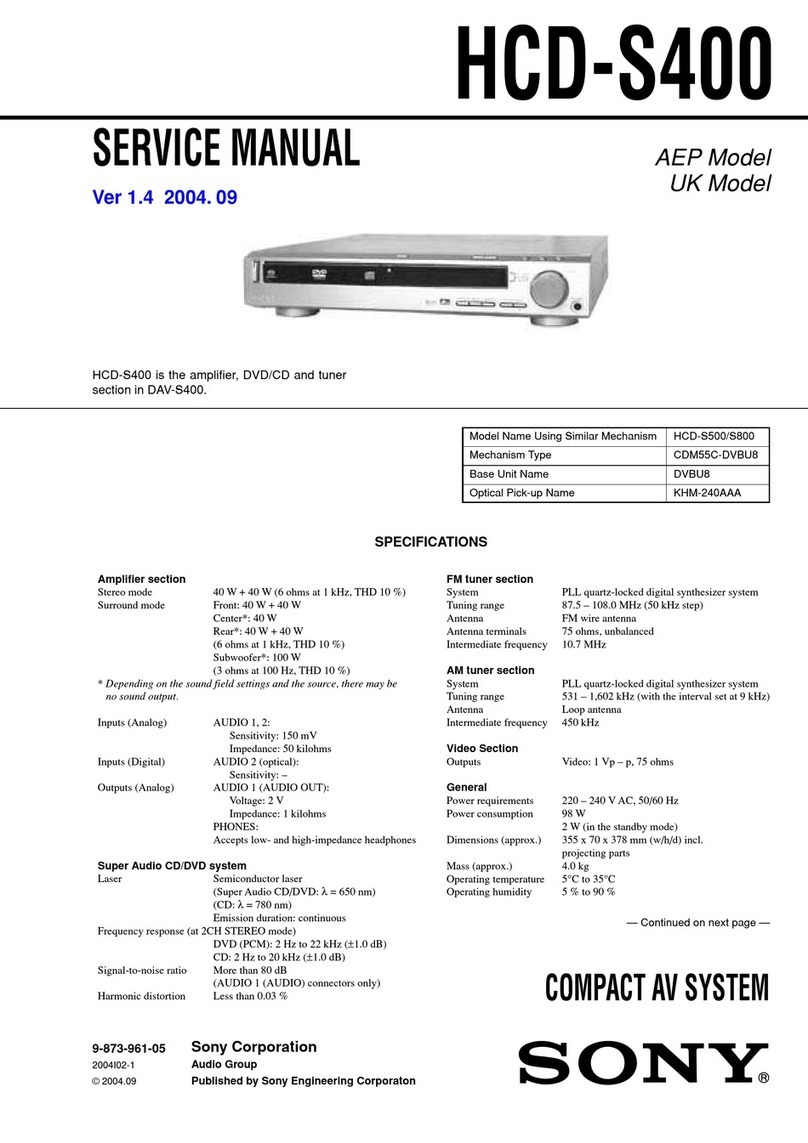
Sony
Sony HCD-S400 User manual

Sony
Sony STR-DH750 User manual
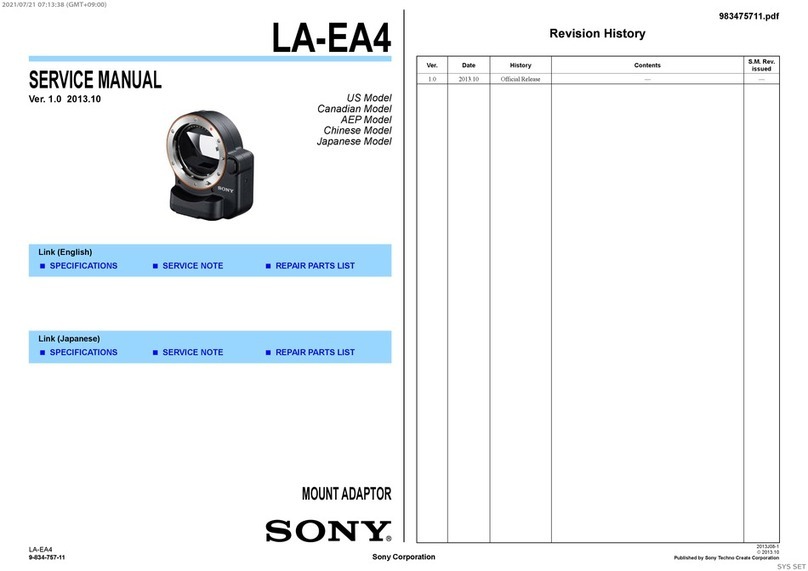
Sony
Sony LA-EA4 User manual
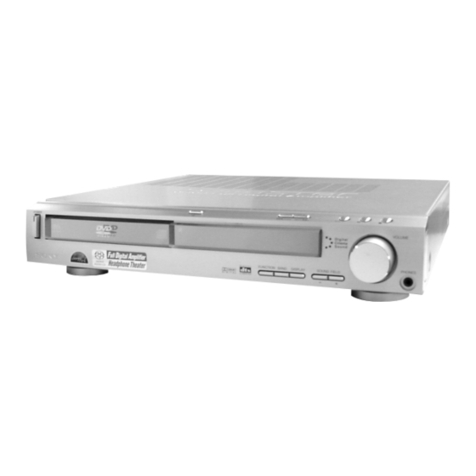
Sony
Sony SS-TS500 User manual

Sony
Sony STR-DG1100 User manual

Sony
Sony STR-DE685 Owner's manual
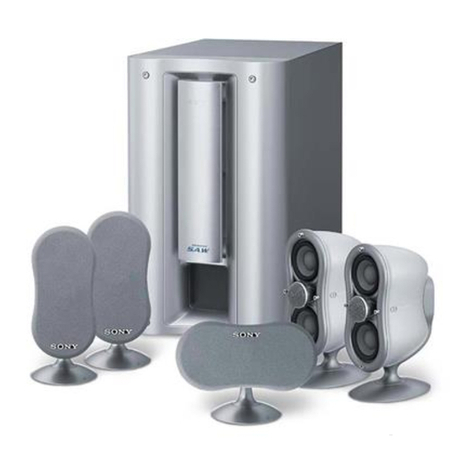
Sony
Sony SA-VE835ED User manual
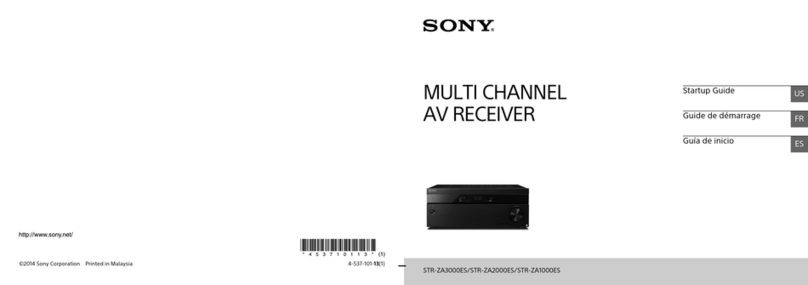
Sony
Sony STR-ZA3000ES User guide
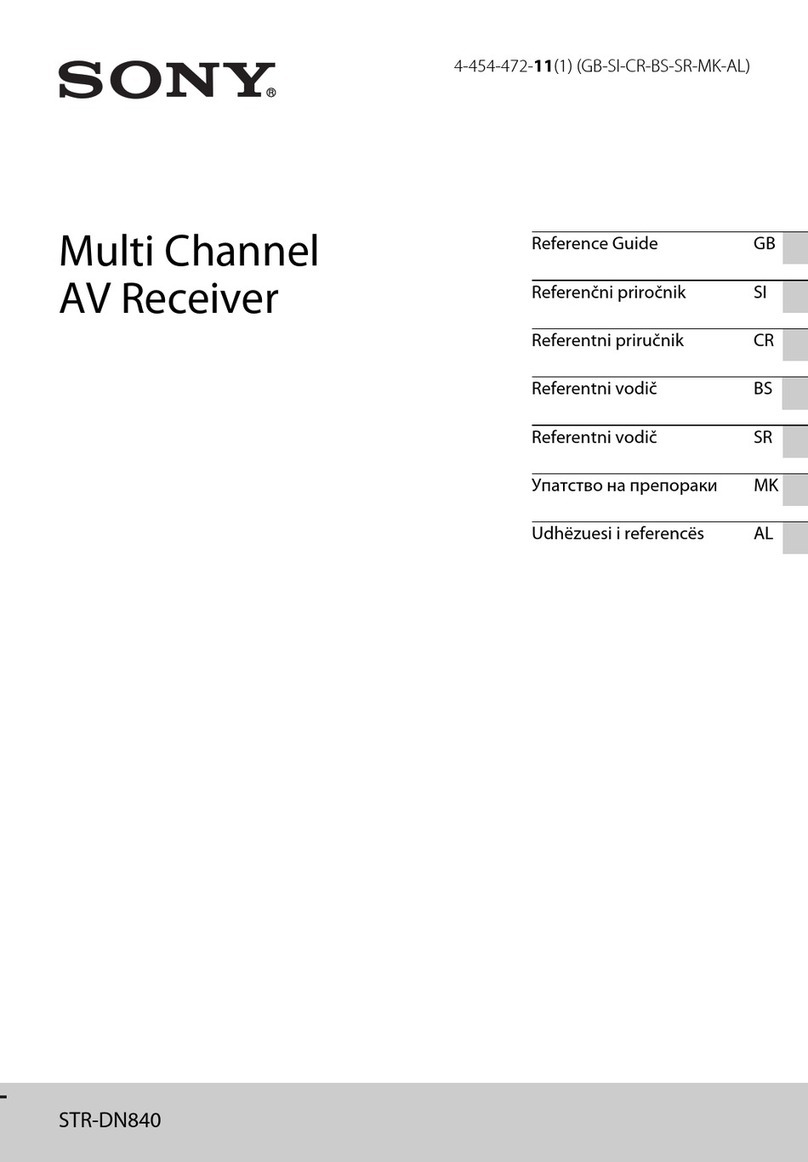
Sony
Sony STR-DN840 User manual
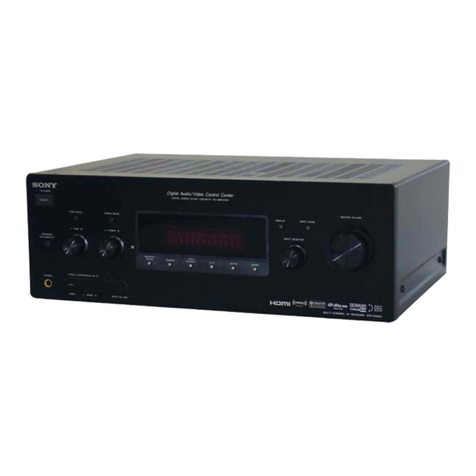
Sony
Sony STRDG820 - STR AV Receiver User manual
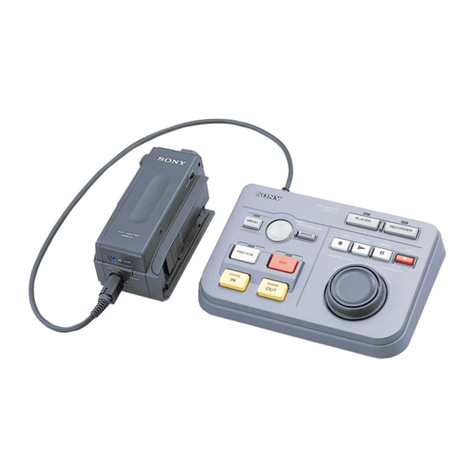
Sony
Sony DSRM-E1 User manual

Sony
Sony DRC-BT30 User manual

Sony
Sony STR-DH730 User manual
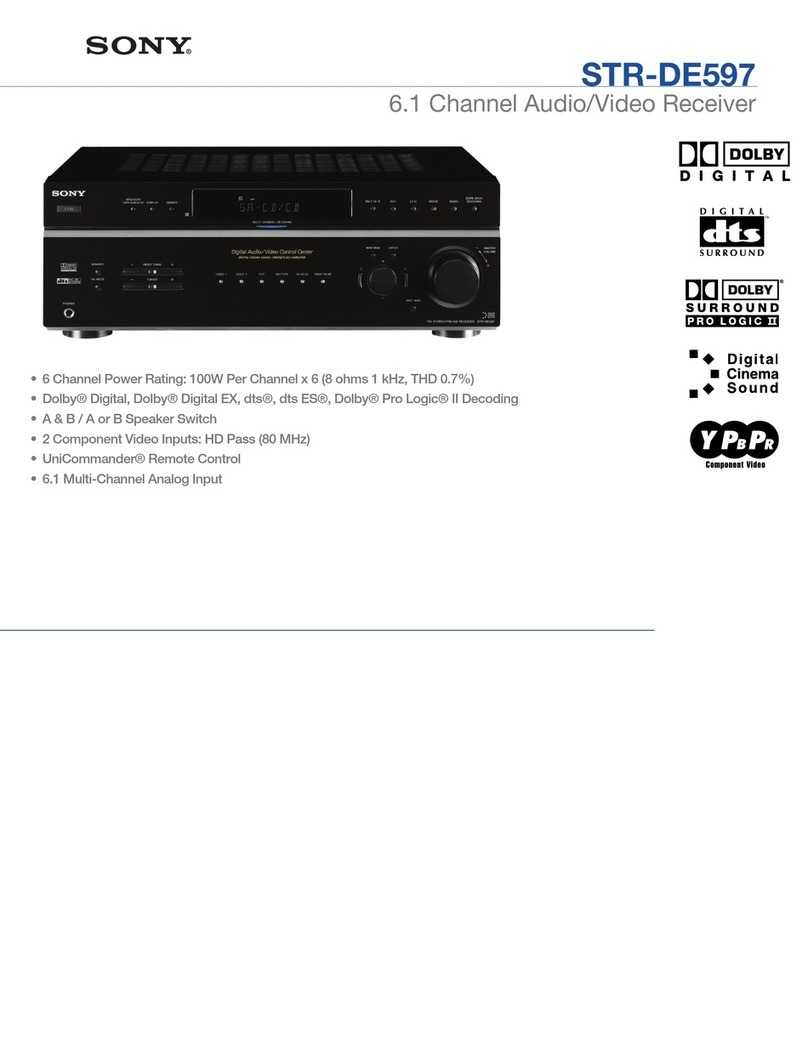
Sony
Sony ST-RDE597 User manual

Sony
Sony STR-DH510 - 10str Hifi User manual
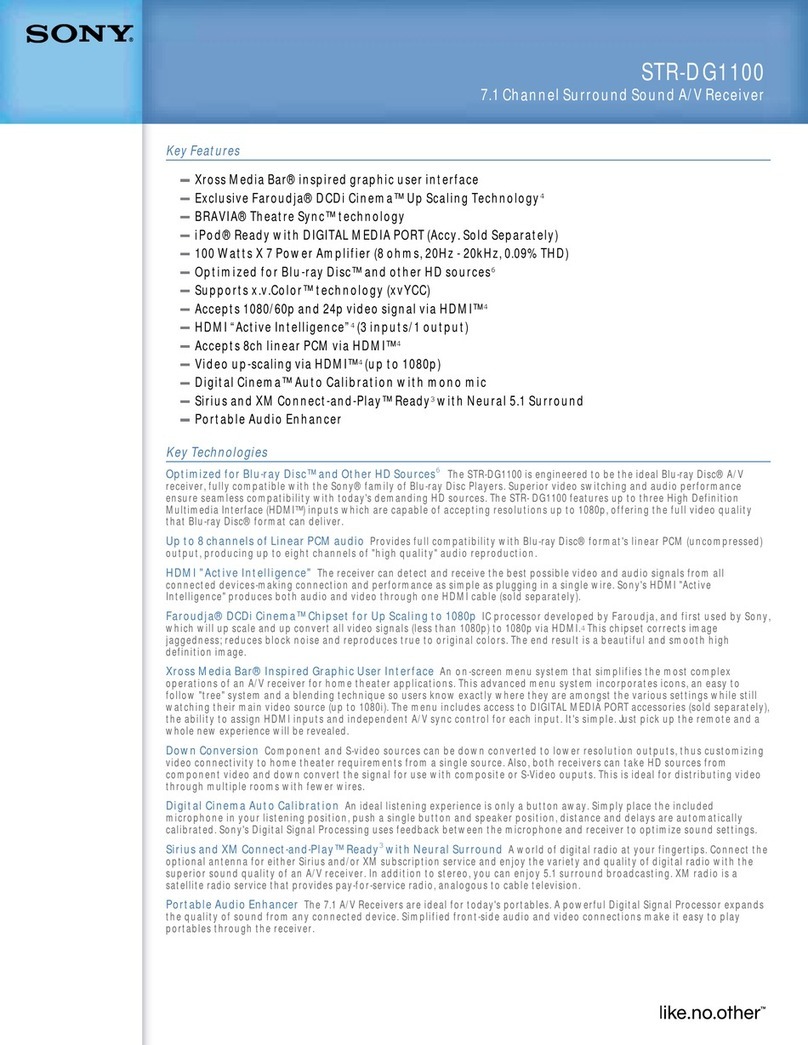
Sony
Sony STR-DG1100 User manual

Sony
Sony STR-DG810 User manual
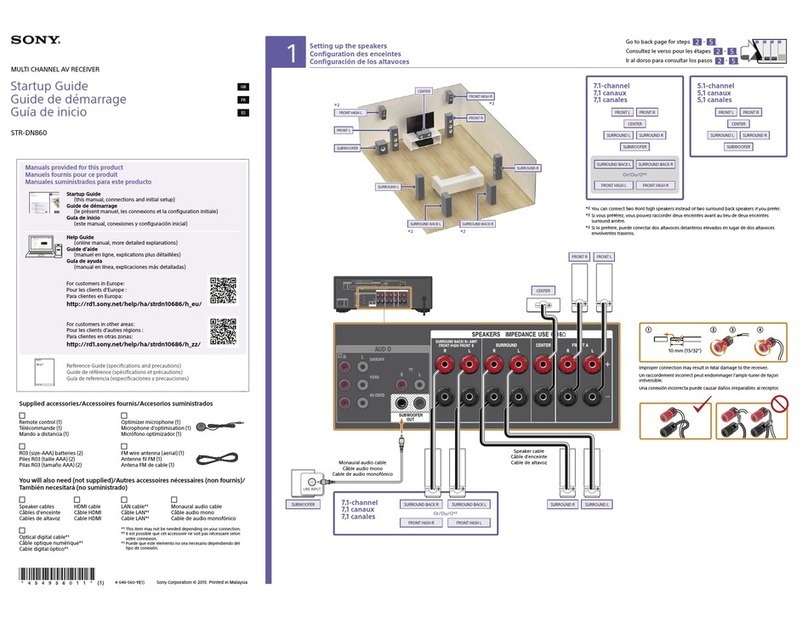
Sony
Sony STR-DN860 User guide
